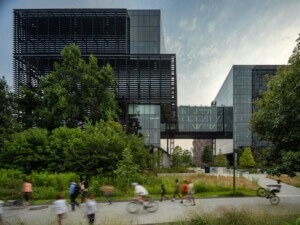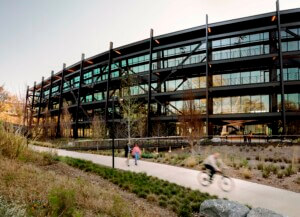The Georgia World Congress Center Authority (GWCCA) has just released new renderings for the renovation of Atlanta’s Centennial Olympic Park. Built for the 1996 Summer Olympics and located in the core of Atlanta’s downtown, the 21-acre park is one of the city’s most frequented green spaces, crowned at its north end by a trio of tourist magnets: the Georgia Aquarium, World of Coca Cola, and the Children’s Museum of Atlanta. Construction has already been underway for most of the year.
The improvements focus on six specific areas of the park with staggered timelines for each. Phase One, which includes renovations of the West Lawn Promenade and the Fountain of Rings Plaza, is slated for completion in January 2018, while Phase Two, which includes a new events center, renovated amphitheater, streetside water feature, and Paralympic Plaza, is expected to wrap up in early 2019. The new renderings are also an improvement on those released in March 2017, which mostly depicted flatly nondescript grassy spaces with little appeal.
Phase One largely targets footpaths and plazas. During this phase, a road that used to cut through the park, Andrew Young International Boulevard, will be completely pedestrianized.
Many of the designs for the park leave much to be desired, with their monotoned pathways, expanses of shadeless lawn, and lack of seating or plant variance. Thankfully, some shade structures will be built near the Southern Company Amphitheater–in southern climes like Atlanta with year-round heat, temperature matters.
According to the GWCCA, the park’s legacy is twofold: to preserve and honor the Olympic Games of 1996, but also to ground development efforts downtown in an accessible public space. The organization was created in 1971 to create a convention center for downtown Atlanta, and now manages a number of properties around the park including the Georgia World Congress Center, the Georgia Dome, and the New Atlanta Stadium, as well as a conference center to the south in Savannah.
Many cities left with vast, expensive spaces after hosting the Olympics face the question of how to repurpose and maintain them once the games are over–here, the GWCCA appears to have stuck to the model of keeping a banal park space to fuel corporate development at its fringes.










